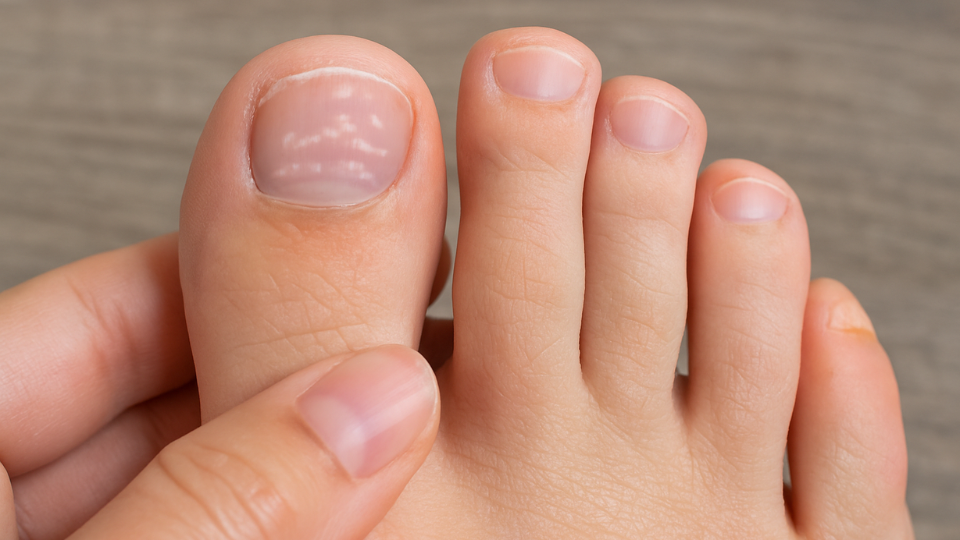Top of Foot Hurts After Running? Causes, Injuries, and How to Treat It
Learn the key differences between corns and bunions, their symptoms, and treatment options. Book an appointment with FAS The Woodlands for expert foot care.

White marks under toenails are a common concern that can appear suddenly and leave you wondering whether it’s just cosmetic or something more serious. While these marks are often harmless, they can also be an early sign of infection, injury, or even nutritional deficiencies. Understanding what’s behind these nail changes is the first step toward restoring healthy, natural-looking toenails.
The medical term for the white discoloration in the nail is leukonychia. When you notice white marks under your toenails, they might look like tiny dots, streaks, or larger patches beneath the nail plate. Depending on the cause, these marks can appear on one nail or several and may fade as the nail grows or persist if there’s an underlying condition.
One of the most frequent causes is physical trauma such as stubbing your toe, wearing tight shoes, or even bumping your foot during a workout. These small injuries can damage the nail matrix (the area under the skin that produces new nail cells), leading to white spots or patches that move upward as the nail grows.
To prevent trauma-related marks:
Fungal infections are another leading cause of white marks under the toenails, especially if the nail also looks thick, brittle, or discolored. In some cases, the white appearance comes from trapped keratin debris or the fungus itself spreading beneath the nail plate.
If a fungal infection is the culprit, over-the-counter antifungal creams may not be enough since they don’t penetrate deeply into the nail. A podiatrist can perform a proper nail culture or microscopic exam to confirm the diagnosis and recommend prescription antifungal treatments or laser therapy.
For practical steps you can take at home, explore our guide on 5 Ways to Keep Your Toenails Healthy and Fungus-Free for everyday tips that support strong, healthy nails and prevent future discoloration.
Lack of essential nutrients, especially zinc, calcium, or protein, can sometimes lead to white marks under your toenails. When your body is low on these nutrients, nail cells can become weak and prone to discoloration.
Tips to support healthy nails:
If you suspect a deficiency, your doctor can run simple blood tests and help you adjust your nutrition accordingly.
Frequent use of nail polish, polish remover, or harsh cleaning products can dry out the nail bed and cause white marks. The chemicals in acetone and some nail products strip natural oils from your nails, leaving them dull or unevenly colored.
To minimize damage:
Sometimes, white marks under your toenails could indicate more serious health concerns. Conditions such as psoriasis, eczema, liver disease, or kidney problems can affect nail growth and color. In these cases, white spots often appear alongside other symptoms like nail pitting, thickening, or ridging.
If your nail changes are persistent, spreading, or accompanied by pain or swelling, it’s best to schedule an evaluation with a podiatrist or primary care physician. And if you’re dealing with other nail-related discomforts, such as tenderness or pain near the nail edge, you may also find our article on Side of Toenail Hurts But It’s Not Ingrown? Here’s What Might Be Going On helpful for understanding possible causes and treatment options.

Keeping your toenails healthy goes beyond cosmetics, it’s about protecting the nail structure and surrounding skin. Try these daily habits to prevent white marks under the toenails from returning:
While many white spots are harmless, you should see a doctor or podiatrist if you notice:
A podiatrist can identify whether you’re dealing with a fungal infection, trauma, or systemic condition and recommend the right treatment to prevent recurrence.
If you’re experiencing ongoing nail or foot problems, it may be time for a professional evaluation. Learn more about the key warning signs in our guide, When to See a Podiatrist: 10 Signs You Shouldn’t Ignore.
White marks under your toenails might seem minor, but they can sometimes signal a deeper issue. Whether it’s fungal, nutritional, or mechanical, proper diagnosis ensures you get the right care to restore healthy, clear nails.
If you notice persistent white marks, discoloration, or changes in your toenail texture, don’t wait for it to worsen. Our experienced podiatrists at FAS The Woodlands can identify the cause and guide you toward effective, lasting treatment.
Book an appointment today to get expert evaluation and personalized foot and nail care from our board-certified specialists.

Learn the key differences between corns and bunions, their symptoms, and treatment options. Book an appointment with FAS The Woodlands for expert foot care.